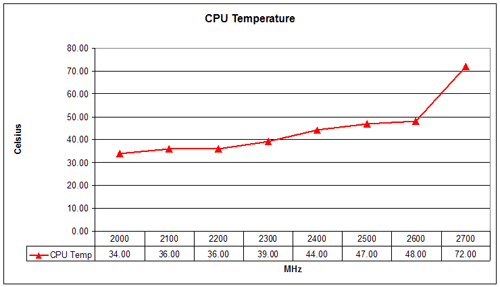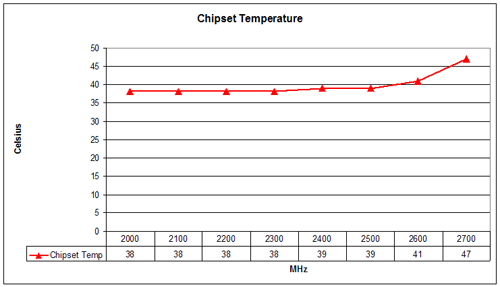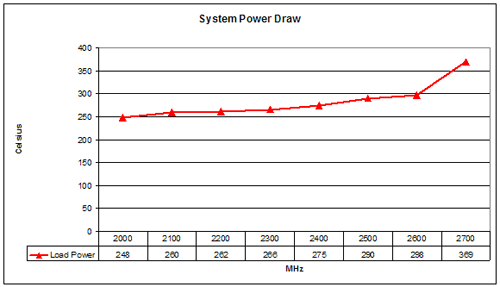Investigations into Athlon X2 Overclocking
by Jarred Walton on December 21, 2005 12:00 PM EST- Posted in
- CPUs
Power and Heat
One area that we overlooked last time was the system power draw as well as the CPU temperature. We spent some additional time measuring these items with the X2. Total power draw was measured at the wall using a Kill-A-Watt device. We used a batch file to run 3DMark03, 3DMark05, PCMark04, and PCMark05 sequentially. The maximum power draw invariably came during 3DMark05, with all three game tests falling very close together. Test 1 (Return to Proxycon) and test 2 (Firefly Forest) typically registered a few Watts higher than test 3 (Canyon Flight ), though this trend may not hold with other system configurations. Also, since we were overclocking, AMD's Cool 'n Quiet feature was disabled - it tends to interfere with overclocking efforts.
In addition to measuring the power draw, we used NVIDIA's nTune System Monitor to record temperatures of the chipset and processor. While we would be hesitant to use the results from nTune across different motherboards due to potential variance, since we are only using one motherboard, the values are measured consistently. The temperatures were measured using the same series of tests, with the 3DMark05 CPU test causing the highest recorded temperatures. (Note that the benchmark results for Futuremark products were collected in a separate run of these tests so that nTune wouldn't impact the results.)
We only recorded temperatures and power draw for one configuration, using the OCZ VX RAM - staring at a Watt meter for 20 minutes per configuration was already bad enough! Informal checks on other configurations showed that the results were consistent - additional RAM in the 2GB configurations drew a bit more power, but CPU and chipset temperatures were within 1 degree Celsius. Also, unlike the remaining benchmarks, we verified the voltage requirements, power draw, and temperatures at every setting in 100 MHz increments.
For those who prefer a graphical representation of the data, here are the charts for the above table.
It comes as no surprise that both the power draw and CPU temperatures increase as clock speed and voltage increase. The jump from 2.6 GHz to 2.7 GHz comes with a dramatic change in CPU temperature, and we would definitely advise against running this particular CPU at 2.7 GHz without additional cooling. Voltage and heat are good indicators of the maximum stable speed for a CPU, so if you're trying to find your own CPU's sweet spot, you can do so by increasing speed in 100 MHz increments. Run a few CPU intensive tests at each point to verify that the system is "stable" - Futuremark products are pretty good as an overall system stress test. Lather, rinse, and repeat. Slight increases in CPU voltage (and chipset voltage) will usually be required as the clock speed is raised, but eventually you reach a point where the next 100 MHz bump requires a substantial voltage change and comes with much higher temperatures.
Looking at our chart, you can see that most of the 100 MHz increases required a 0.00 to 0.050 CPU voltage increase. From 2.4 GHz to 2.6 GHz, we had to add 0.10V, but that's still not too bad. The last 100 MHz to reach 2.7 GHz required an additional 0.20V - four times as much per MHz as the previous step! We also tried every voltage from 1.500V to the maximum 1.850V and were unable to get the system fully stable at 2.7 GHz. That's a lot of voltage for a CPU rated at 1.300V, but we gave it a shot anyway. For most people, we'd say 1.500V is the safe limit on air cooling, though some people will feel okay pushing a bit further. We also recommend that you try to keep 90nm AMD chip temperatures under 50 degrees C. As you can see, the 2.7 GHz speed exceeds both of these thresholds, and it doesn't even do so with full stability. 2.6 GHz, on the other hand. falls in line with these limits and ran without any difficulty - at least with our particular setup.
One final note is that the power draw and temperatures can vary a lot with the task. Most games showed similar maximum power draw to 3DMark05 in informal testing, but usually only under high-stress situations. HL2 ranged from about 205W maximum at 800x600 0xAA to 262W maximum at 1600x1200 4xAA (with a CPU clock speed of 2.20 GHz). The average power draw under load was also quite a bit lower than the peak values reported; generally, average power was 15 to 25 Watts lower than the maximum.
By the way, yes, we are aware that measuring power at the outlet is not the same as measuring the output power of the PSU. Power supply inefficiencies come into play, but since we're only using one PSU (and this isn't a power supply test), the numbers are still valid. An inefficient power supply will draw more power from the wall, but the results shown are internally consistent.
One area that we overlooked last time was the system power draw as well as the CPU temperature. We spent some additional time measuring these items with the X2. Total power draw was measured at the wall using a Kill-A-Watt device. We used a batch file to run 3DMark03, 3DMark05, PCMark04, and PCMark05 sequentially. The maximum power draw invariably came during 3DMark05, with all three game tests falling very close together. Test 1 (Return to Proxycon) and test 2 (Firefly Forest) typically registered a few Watts higher than test 3 (Canyon Flight ), though this trend may not hold with other system configurations. Also, since we were overclocking, AMD's Cool 'n Quiet feature was disabled - it tends to interfere with overclocking efforts.
In addition to measuring the power draw, we used NVIDIA's nTune System Monitor to record temperatures of the chipset and processor. While we would be hesitant to use the results from nTune across different motherboards due to potential variance, since we are only using one motherboard, the values are measured consistently. The temperatures were measured using the same series of tests, with the 3DMark05 CPU test causing the highest recorded temperatures. (Note that the benchmark results for Futuremark products were collected in a separate run of these tests so that nTune wouldn't impact the results.)
We only recorded temperatures and power draw for one configuration, using the OCZ VX RAM - staring at a Watt meter for 20 minutes per configuration was already bad enough! Informal checks on other configurations showed that the results were consistent - additional RAM in the 2GB configurations drew a bit more power, but CPU and chipset temperatures were within 1 degree Celsius. Also, unlike the remaining benchmarks, we verified the voltage requirements, power draw, and temperatures at every setting in 100 MHz increments.
| Power and Temperatures | |||||
| OCZ Gold VX PC4000 2x512MB | |||||
| CPU Clock | CPU Voltage | CPU Temp | Chipse Voltage | Chipset Temp | System Power Draw |
| 2000 | 1.300 | 34.00 | 1.50 | 38 | 248 |
| 2100 | 1.350 | 36.00 | 1.50 | 38 | 260 |
| 2200 | 1.350 | 36.00 | 1.50 | 38 | 262 |
| 2300 | 1.350 | 39.00 | 1.50 | 38 | 266 |
| 2400 | 1.400 | 44.00 | 1.60 | 39 | 275 |
| 2500 | 1.475 | 47.00 | 1.60 | 39 | 290 |
| 2600 | 1.500 | 48.00 | 1.60 | 41 | 298 |
| 2700 | 1.700 | 72.00 | 1.70 | 47 | 369 |
For those who prefer a graphical representation of the data, here are the charts for the above table.



It comes as no surprise that both the power draw and CPU temperatures increase as clock speed and voltage increase. The jump from 2.6 GHz to 2.7 GHz comes with a dramatic change in CPU temperature, and we would definitely advise against running this particular CPU at 2.7 GHz without additional cooling. Voltage and heat are good indicators of the maximum stable speed for a CPU, so if you're trying to find your own CPU's sweet spot, you can do so by increasing speed in 100 MHz increments. Run a few CPU intensive tests at each point to verify that the system is "stable" - Futuremark products are pretty good as an overall system stress test. Lather, rinse, and repeat. Slight increases in CPU voltage (and chipset voltage) will usually be required as the clock speed is raised, but eventually you reach a point where the next 100 MHz bump requires a substantial voltage change and comes with much higher temperatures.
Looking at our chart, you can see that most of the 100 MHz increases required a 0.00 to 0.050 CPU voltage increase. From 2.4 GHz to 2.6 GHz, we had to add 0.10V, but that's still not too bad. The last 100 MHz to reach 2.7 GHz required an additional 0.20V - four times as much per MHz as the previous step! We also tried every voltage from 1.500V to the maximum 1.850V and were unable to get the system fully stable at 2.7 GHz. That's a lot of voltage for a CPU rated at 1.300V, but we gave it a shot anyway. For most people, we'd say 1.500V is the safe limit on air cooling, though some people will feel okay pushing a bit further. We also recommend that you try to keep 90nm AMD chip temperatures under 50 degrees C. As you can see, the 2.7 GHz speed exceeds both of these thresholds, and it doesn't even do so with full stability. 2.6 GHz, on the other hand. falls in line with these limits and ran without any difficulty - at least with our particular setup.
One final note is that the power draw and temperatures can vary a lot with the task. Most games showed similar maximum power draw to 3DMark05 in informal testing, but usually only under high-stress situations. HL2 ranged from about 205W maximum at 800x600 0xAA to 262W maximum at 1600x1200 4xAA (with a CPU clock speed of 2.20 GHz). The average power draw under load was also quite a bit lower than the peak values reported; generally, average power was 15 to 25 Watts lower than the maximum.
By the way, yes, we are aware that measuring power at the outlet is not the same as measuring the output power of the PSU. Power supply inefficiencies come into play, but since we're only using one PSU (and this isn't a power supply test), the numbers are still valid. An inefficient power supply will draw more power from the wall, but the results shown are internally consistent.










46 Comments
View All Comments
JarredWalton - Wednesday, December 21, 2005 - link
Ugh - at a comment on is an article that true special attention to the fact that the graphs aren't zeroed. I think in the process of tweaking article to get things to look right, I accidentally deleted that paragraph. I have now http://www.anandtech.com/cpuchipsets/showdoc.aspx?...">added to paragraph back in.If I start all the graphs at zero, everything overlaps and you can't really see what's going on. In some cases, everything is still overlapped a lot (FEAR). I normally hate nonzero graphs, but when the results are all so close together, that's no good either for readability.
BigLan - Wednesday, December 21, 2005 - link
Well, if everything is overlapping that much, it's likely that the results are too close to be really meaningful. The FEAR graph is a pretty good example of <a href="http://www.amazon.com/gp/product/0393310728/>Ho...">http://www.amazon.com/gp/product/0393310728/"... to Lie With Statistics</a> ;)BigLan - Wednesday, December 21, 2005 - link
^ Still need my edit function for comments. :pDammit
JustAnAverageGuy - Wednesday, December 21, 2005 - link
:)JarredWalton - Wednesday, December 21, 2005 - link
^ Still need my edit function for comments. :pThat was supposed to say, "I had a comment in this article that drew special...." That will teach me to trust my speech recognition software.
Hacp - Wednesday, December 21, 2005 - link
I have found that past 2.6, the heat and temps increase dramatically. Nice to know that anandtech got the same results as well.Yianaki - Wednesday, December 21, 2005 - link
SuperPI crashes help! I have a Opteron 165 with 1 gig of value PC4000 kingmax ram at 133 2.5-4-4-8 2t. Board is OC to 1.4v at 9x277 = 2.494. I have run two torture versions of prime 95 (one of the CPU intensive, one of the ram intensive) on each processor, for a total of 4 prime95's. At the same time I run 3dmark 2005. At the same time I run winamp with visualizations on. I leave this on all night 9hrs+ in a loop. No errors at all. No buggyness at all. I game for 3 or 4 hours at a time and no problems.But I just read this article and SuperPI was mentioned and I never used that before and I tried it. It wouldn't work unless I lowered my overclock to 2.00 which is unacceptable to my sorry ass. I KNOW my system is unstable. I just was wondering if it mattered as the computer is completely stable. I am guessing that prime95 just rounds off answers and they don't have to be exact whereas I am guessing that SuperPI's answers are already known to be exact. Actually SuperPI runs fine but if I open up a second copy from a second folder and attach the affinity to both processors SuperPI will have errors as soon as I start it 1second of starting the 2nd process. Any ideas??
Could it possibly be my motherboard or ram as both are 'value' versions not OC specialty items. I have already played around with rendering divx movies and playing doom no problem. Will I probably have some problem down the road or like some small encoding error or dvd writing error that is due to my overclock. I Overclocked my old PII too high and it was spewing out bad math. I did all these chem reports in college and was getting completly off the wall numbers (I never tested my PII oc in prim95). Is this the same or does the error correcting in my programs that I am running in XP make this point moot.
Man I wish I never read about superPI poo :<
Furen - Wednesday, December 21, 2005 - link
Superpi and prime95 work differently. I think superPI is more reliant on memory bandwidth (if you're doing something like 32M superPi) so your ram may be the problem (I, personally, like crucial ram, I've never had any problems with it at all, and its not much more expensive than the generic crap). If your system doesnt crash when you're doing whatever it is that you do on your computer then you're fine, though, but I'd still try to work on the ram to see if you can get it to be superpi stable.Yianaki - Wednesday, December 21, 2005 - link
It just gets wierder and wierder... If I don't set the affinity manually in the task manager it will run through to the end and the CPU's will both be at 100%. But if I set them manually in the task manager before I start 32M the second one I start always crashes? I am guessing that the task manager isn't running the processors at 100% or something, as the windows task manager is automatically putting the loads on the two cpus and for a milisecond one isn't doing anything???? My Memory is up to 95% utilization... This proggie sucks if you ask me.Yianaki - Wednesday, December 21, 2005 - link
Thanks for the feedback. BTW it is Kingmax Super Ram, Dual channel mate. My motherboard is a ASRock 939 dual sata-2. Bought it because it runs AGP and PCIe quickly. I have my ram underclocked normally it can run at 200 but is running at 133 normally, I also lowered it to 100. I lowered all the timings lower than what the spd says. None of these things help... I am really confused. I run the Blend (ram intensive) test on each processor at the same time as the FFT test in prime 95. Memory usage goes up to 1.5 gigs total (I only have a gig), so that is using all the memory + page. But there is no error at all. I am a little dumbfounded but I have been thinking about it and my computer doesn't have any 'random' errors which is fine. Cept for firefox 1.5 and it had the same occasional problems before my upgrade. Oh well hope everything stays stable. Thanks for the feedback.